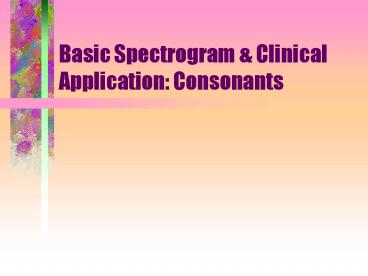Basic Spectrogram - PowerPoint PPT Presentation
1 / 23
Title:
Basic Spectrogram
Description:
Basic Spectrogram & Clinical Application: Consonants. Sonarants ... Gradual transitions that appear on the spectrogram as a slowly changing formant pattern ... – PowerPoint PPT presentation
Number of Views:1406
Avg rating:3.0/5.0
Title: Basic Spectrogram
1
Basic Spectrogram Clinical Application
Consonants
2
Sonarants
- Consonant that manipulates vocal tract resonance
- Characteristics
- F2 F3 formant changes
- Transitions
- Include
- Nasals /m/, /n/ /h/
- Liquids /r/, /l/
- Glides /w/, /j/
3
Sonorants
- Production involves a greater constriction when
compared to vowels and a quicker more extreme
movement of the vocal tract compared to
diphthongs - Movements and formant transitions slower than all
other consonants
4
Nasals
- Low frequency energy (near Fundamental
Frequency)- Nasal Murmer - Place of nasal articulation is defined by the 2nd
formant transition place of antiresonances
5
m
n
a
a
Nasal Murmur
Spectrogram Nasals
6
Glides
- Semivowels /j, w/
- Gradual transitions that appear on the
spectrogram as a slowly changing formant pattern - Formant transitions
- Duration 75-150 ms
7
Spectrogram Glides
8
Liquids
- Liquids /l, r/
- Formant pattern steady state and transition is
the primary acoustic cue - Prolongation effects
- /l/ steady state formants
- F1 360 Hz
- F2 1300 Hz
- F3 2700 Hz
- /r/ steady state formants
- Same F1 F2 as /l/ but much lower F3
9
Spectrogram Liquids
l
r
10
Stops
- Acoustic Cues Silent or low energy interval,
burst, transition - Silent interval oral constriction (I.e. closure
of lips for /b/) also termed a stop gap - Voiced stops can be seen on the voice bar as
noise energy - Burst Articulatory constriction is released
energy released looks like noise on the
spectogram - Transition formant transition into following
vowel
11
Stops
- Bilabial Stops (/p/, /b/)
- F1 starts at zero rises to F1 of next vowel
- F2 starts at 800 Hz rises to F2 of following
vowel - F3 increases for following vowel
- Alveolar Stops (/t/, /d/)
- F1 same as for bilabial stops
- F2 starts at 1800 Hz rises to F2 of following
vowel - Velar Stops (/k/, /g/)
- F1 same as for bilabials
- F2 has 2 starting points 1300 2300 Hz
12
Spectrogram with Transitions /d a d/
13
Voiceless Stop Consonants
14
Stops
- Characteristics
- Voice onset time (VOT) time between stop release
(burst) and the onset of glottal pulsing - Voiced shorter VOT
- Longer VOT in cleft palate, dysarthric speakers
and phonological disorders
15
Fricatives
- Spectrum of noise is the acoustic cue formant
transition - Specific location of turbulence
- Labiodental /f,v/
- Low energy, flat diffuse spectra (front cavity is
short with little filtering effect on noise
energy) - Linguadental /q,ð/
- Low energy, flat and diffuse spectra (front
cavity gives little shaping to spectrum) - Lingu-alveolar /s, z/
- High energy noise spectra, energy lying in high
frequencies (above 4 kHz) (front cavity longer
contributing to distinctive spectral shaping) - Linguapalatal /sh, zh/
- Intense noise spectra, energy lying in mid to
high frequencies (above 2kHz) (front cavity
significant resonance effect)
16
Spectrum Changing Pattern of Fricative Noise
17
Fricatives Spectrum
Higher energy spectra
Low to mid energy spectra
18
Affricates
- Affricate consonants have a stop gap (silence,
low energy interval) followed by intense
frication - Stop gap articulatory closure
- Frication noise after closure is released
19
Spectrogram /judge/
20
Laboratory
- Part I SONORANTS
- Nasal Consonants
- Make a wide-band spectrogram of
- mow, no
- Draw a vertical line where consonant ends and
vowel begins - Locate nasal murmer, 1st 2nd formants,
antiresonances - What spectral differences do you see?
- Locate the 2nd formant transitions on both. What
are the differences? - Some, Sun
- Label the same as the first spectrogram
- Contrast both spectrograms
21
Laboratory
- Part II Approximants
- Glides Liquids
- Wide band spectrogram of a ray, a lay, a
way, a yea - Label each phone on the spectrogram
- Compare /r/ /l/
- Determine the relative frequency of F1, F2 F3
- Determine whether there is acoustic energy
present at higher frequencies is low or high - What acoustic characteristics are different
between consonants?
22
Laboratory
- Part III Silibants
- Fricatives
- Say sigh and shy at a moderate rate
- Obtain a wide-band spectrogram (at least 8 kHz)
- Locate label each phone
- What are the spectral characteristics that
distinguish it from vowels and other consonants?
23
Laboratory
- Part II Nonsilibnts
- Obtain a wide-band spectrogram of high, fie
and thigh - Label each phone
- What spectral features distinguish phones?
- How do they differ from silibants?
- Obtain a wide-band spectrogram of ether and
either - Label

